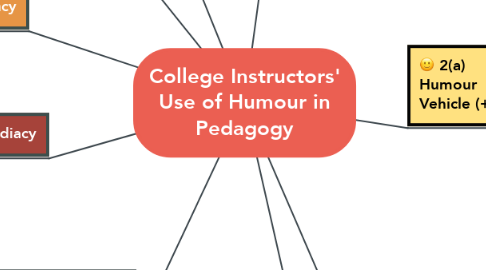
1. 4. Rationale for Use by Instructor
1.1. Stress/Tension Diffusing, "lightening up" learning atmosphere
1.2. Modeling humour approach in field of work
1.3. Enhancing student learning/engagement
1.4. Tool for relationship building; removing relationship barriers
2. 3. Humour Impact & Qualities
2.1. (+)
2.1.1. Humanizing Instructor
2.1.2. Increasing student understanding/retention of content
2.1.3. Establishing open, collaborative classroom climate
2.1.4. Neurological/physiological benefits
2.2. (-)
2.2.1. Crossing boundaries/lines/professionalism
2.2.2. Playing on student vulnerabilities
2.2.3. Compromising Instructor credibility
2.2.4. Risk of misinterpreting
3. 5. Influences on Immediacy
3.1. Reciprocal (teacher-student)
3.2. Breaking down student-teacher boundaries
3.3. Enhancing perceived relating/connectedness
3.4. Humanness
4. 8. Personal Teaching Philosophy
4.1. Cheerleading v. professorial
4.2. Educational worldview
5. 7. Teaching Enjoyment
5.1. Academic freedom as deal-breaking
5.2. As energy-giving/affirming
5.3. For personal amusement/fun
5.4. Reciprocal student-teacher joy; emotional transmission
6. 6. Teacher Efficacy
6.1. Based on student feedback
6.2. Based on Instructor perception
7. 2(b) Humour Vehicle (-)
7.1. Crude/crass humour
7.2. Crossing the 'fine line'/boundaries
7.3. Dark/Black humour
7.4. Joking about sensitive content
7.5. Oversharing personal stories
7.6. Overuse of self-deprecation
7.7. Prejudicial
7.8. Put-downs/Mocking/Centering-out
7.9. Sarcasm
7.10. 'Schadenfreude'
7.11. Shock Humour
8. 2(a) Humour Vehicle (+)
8.1. Verbal Transmission
8.1.1. Conversing
8.1.2. Dark/black Humour
8.1.3. General Wit (lecture)
8.1.4. Inappropriate/GentleTeasing
8.1.5. Sarcasm
8.1.6. Self-deprecating
8.1.7. Shock Humour
8.1.8. Storytelling (personal/professional)
8.2. Nonverbal Transmission
8.2.1. Facial Expressions/Gesticulations
8.2.2. Static Visual Media (photos, GIFs, Memes)
8.2.3. Music/Dance
8.2.4. Games/Play/ Physicality/ Physical Humour
8.2.5. Humour in Tests/Exams/LMS/Other
8.2.6. Dynamic Media YouTube/TV/Film *(V/NV)

